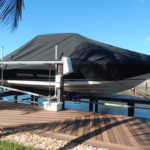Boat safety kit requirements are easy to follow if you are informed. The length of your boat and the local legislation are the determinants for these requirements.
In the U.S., 5 USCG (United States Coast Guard) boat safety kit requirements include:
- Personal Flotation Device: USCG-approved O’Neill USCG Reactor Life Vest – Click here to see it on Amazon – Our #1 Top Pick!
- Fire Extinguisher: Kidde 466180 Pro 5 Carbon Dioxide – Click here to see it on Amazon
- Visual Distress Signals Like the Sirius Signal SOS LED Electronic Visual Distress Signal
- Sound Devices: Whistle, Bell, or Horn
- Backfire Flame Arrestor: At least two vents for every fuel compartment or closed engine
Each person needs a personal flotation device (PFD) while on boats in the U.S. Other equipment needed to be found in boats while in American waters includes a fire extinguisher, a whistle or bell, and visual distress signals.
The boat’s engine compartment should also have at least two ventilation ducts.
These are the boat safety kit requirements you should follow to have greater peace of mind when venturing out on the water. Based on the requirements of USCG or the U.S. Coast Guard, smaller boats require less equipment, and larger boats have more requirements.
Read on to learn more about the 5 USCG boat safety requirements, including the specific features of each.
Also, we hope you find the links here useful. We may get a commission if you purchase something through a link on this page, so thank you!
Also, for an excellent Personal Flotation Device (PFD), take a look at our top pick, the USCG-approved O’Neill USCG Reactor Life Vest:
Click here to see it on Amazon.
USCG Prerequisite Boat Safety Kit Requirements for Different Boat Sizes
Below are the U.S. Coast Guard requirements for boats of different sizes.
Boats smaller than 16 ft (5 meters)
- Every person on board needs to have one Type I, II, III, or V PFD or Personal Flotation Devices. The PFDs must be Coast Guard approved, readily accessible, and fit the user.
- One B-I or any Coast Guard-approved fire extinguisher. Boats with permanent fuel tanks, without onboard engines, such as having no engine or outboards, and a fixed system are not required to have a fire extinguisher.
- Visual distress signals can be seen during nighttime if the boat is sailing at night. The visual distress signals include 1. One LED electric distress signal; 2. One hand-held red flare, not more than 42 months old.
- Whistle, horn, or bell
- Vessel lighting
- At least two vents for every fuel compartment or closed engine
- Backfire Flame Arrestor
Boats between 16 and 26 ft (5 to 8 meters)
- Every person on board needs to have One Type I, II, III, or V Coast guard approved PFD or personal flotation device. A throwable Coast Guard-approved PFD or Type IV should also be included. All PFDs on board must be readily accessible and fit each user.
- One B-I or any Coast Guard-approved fire extinguisher. Boats with permanent fuel tanks, without onboard engines, such as having no engine or outboards, and a fixed system are not required to have a fire extinguisher.
- Highly visible day and nighttime visual distress signals. The visual distress signals include 1. One LED electric distress signal; 2. One Hand-held red flare, not more than 42 months old; 3. Two parachute flares; 4. One hand-held orange smoke signal; 5. Two floating orange smoke signals
- Recommended whistle, bell, or horn
- At least two vents for every fuel compartment or closed engine
- Vessel lighting
- Backfire Flame Arrestor
Boats between 26 to 40 ft (8 to 12 meters)
- Every person on board needs to have One Type I, II, III, or V Coast guard approved PFD or personal flotation device. A throwable Coast Guard-approved PFD or Type IV should also be included. All PFDs on board must be readily accessible and fit each user.
- One B-I or B-II Coast Guard approved Fire extinguisher. Only 1 B-I is needed if your boat has a fixed system.
- Highly visible Day and nighttime visual distress signals. The visual distress signals include 1. One LED electric distress signal; 2. One Hand-held red flare, not more than 42 months old; 3. Two parachute flares; 4. One hand-held orange smoke signal; 5. Two floating orange smoke signals
- Recommended whistle, bell, or horn
- At least two vents for every fuel compartment or closed engine
- Vessel lighting
- Backfire Flame Arrestor
Recommended Boat Safety Kit Items
Read on to learn more about the following requirements:
- Personal Flotation Device for Every Person On Board
- Fire Extinguisher
- Visual Distress Signals
- Sound Devices: Whistle, Bell, or Horn
- At Least Two Vents for Every Fuel Compartment or Closed Engine
1. Personal Flotation Device for Everyone On Board
“Personal flotation device” is actually a fancier name for “life jackets.” The USCG is quite strict on PFDs, claiming that 84% of drowning incidents when people go overboard could have been avoided if they wore proper life jackets.
There are several types of life jackets, including the throwable type and wearable type. The USCG does not approve inflatable life jackets. Approved life jackets include:
- Type I – called Offshore Life Jackets – provide the most buoyancy, making them perfect for rough waters.
- Type II – called Near-Shore Vests – is the one to wear when rescue is near smooth waters.
- Type III – called full-sleeved jackets or flotation aids – is usually used when sailing in calm waters.
- Type IV – called throwable devices – are ring buoys or cushions thrown to help people in trouble.
- Type V – called special-use devices – waterskiing, windsurfing, or kayaking use these hybrid types of PFDs.
Recommended Personal Flotation Devices:
The USCG-approved O’Neill USCG Reactor Life Vest is a literal lifesaver to use in varied water sports from tubing, wake sports, swimming, and waterskiing.
Click here to see it on Amazon.
An unparalleled feeling of security is created with the heavy-duty front zipper and quick-release safety buckles. A comfortable fit is guaranteed with the expansion panels and full mobility ability from the minimal bulk design.
Having the throwable USCG-approved Flowt Type IV Foam Cushion meets the boat safety kit requirements – for boats longer than 16 feet.
Click here to see it on Amazon.
This must-have equipment has to be part of the safety kit when boating in U.S. waters.
2. Fire Extinguisher
Fire extinguishers are classified into three classes: A, B, and C. A fire source represents each class:
- Class A: Wood or combustible solids
- Class B: Gasoline or any flammable liquids
- Class C: Circuitry of electrical fires
Gasoline fires are the main concern in boats which makes the class B fire extinguisher the most common. A number usually follows the class letter. Class B, for instance, may show a B-I or B-II. The capacity of the extinguisher is the indicator for the number.
- One B-I fire extinguisher is needed for small boats measuring 26 feet (8 meters) or less.
- One high capacity B-II fire extinguisher is needed for larger boats measuring 26 feet (8 meters) or more.
Recommended Fire Extinguisher:
Rechargeable and corrosion-resistant, the Kidde 466180 Pro 5 Carbon Dioxide is a B-I class extinguisher designed to fight flammable liquids as well as electrical fires.
Click here to see it on Amazon.
The extinguisher can be securely placed in the boat using the strap and bracket feature. Tampering and accidental discharge are prevented from happening with the safety seal in the metal pull pin.
3. Visual Distress Signals
One of the most important items of the safety kit is visual distress signals. These ensure people would be able to find you if you get lost or have boat problems.
- Below 16 feet, small boats need to bring along visual distress signals only when sailing at night. Daytime visual signals are not a USCG requirement for small boats.
- More than 16 feet large boats need to carry 3 night and 3-day visual distress signals while sailing.
USCG compliant, the Sirius Signal SOS LED Electronic Visual Distress Signal is the best companion to have when sailing during the day or at night.
Click here to see it on Amazon.
The distress signal flag provides the best SOS signal during the day, while the long-lasting 60-hour LED provides a signal day or night. The patented lens providing vertical and horizontal beams is highly visible up to 10 nautical miles.
4. Sound Devices: Whistle, Bell, or Horn
Sound devices are great to have when you need to signal your position or intention. The bright colors and the 120-decibel high-pitched noisemaker of the Heimdall Boating Emergency Safety Whistle is a life-saving partner when you need it most.
Click here to see it on Amazon.
The high-pitched sound produced by the whistle can easily be heard up to a 1-mile radius. Made of non-brittle plastic, the colors are of never-fade quality. The whistle is guaranteed to work well in all weather conditions.
5. At Least Two Vents for Every Fuel Compartment or Closed Engine
Gasoline vapor can ignite if your boat engine backfires. This is the reason the USCG requires proper ventilation for your boat’s fuel compartments or closed engine. A backfire flame arrestor is required onboard for any gasoline engine.
Click here to see it on Amazon.
Straightening and smoothing incoming air is the K&N 59-3364 Flame Arrestor. Marine approved, the device is both reusable and washable. Compatibility with your boat engine can be checked further by visiting the official website of the manufacturer.
Additional Boat Safety Kit Equipment
The following additional boat safety kit equipment is not required by USCG; however, these items are great to have onboard any time you go boating:
- Spare parts
- Working anchor
- First aid kit
- Boathook
- Heaving line 50-70’
- Paddle/oar
- Spare clothing wrapped in a waterproof bag
- Tool kit
- Depth sounder
- Compass
- Marine radio
- Bailer/bilge pump
Conclusion – Required Boat Safety Kit
The basic boat safety kit requirements that are USCG approved include:
- Personal Flotation Device: USCG-approved O’Neill USCG Reactor Life Vest – Click here to see it on Amazon – Our #1 Top Pick!
- Fire Extinguisher: Kidde 466180 Pro 5 Carbon Dioxide – Click here to see it on Amazon
- Visual Distress Signals Like the Sirius Signal SOS LED Electronic Visual Distress Signal
- Sound Devices: Whistle, Bell, or Horn
- Backfire Flame Arrestor: At least two vents for every fuel compartment or closed engine
You could be expected to shell out around $150-$250 to complete the requirements. You can go the whole hog and buy more than what is required.
However, keeping to the minimum requirement won’t break the bank and give you peace of mind knowing you are covered in an emergency.
Related reading:














